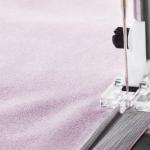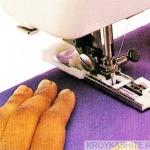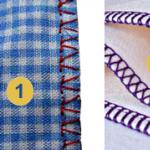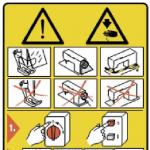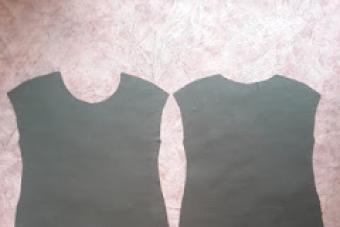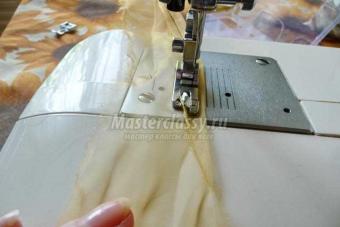A sewing machine and an overlocker are two completely different machines. A sewing machine for domestic purposes, as a rule, performs a two-thread lock stitch. Overlock forms a 3-, 4-, 5-thread overcasting seam based on a chain stitch. Both of these stitches cannot be combined in the same machine. Where, then, did the concept of "overlock sewing machine" come from? The fact is that the first models of zigzag sewing machines were considered to be machines that could overcast, since the zigzag stitch was often used to process the cut edges of the fabric.
Over time, engineers have come up with special overlock feet that allow you to imitate an overlock stitch. In addition, the machines have additional lines that improve the quality of the overcast stitch. Thus, the concept of an overlock sewing machine has become a reality, and in any store you can now buy a machine that can imitate an overlock overlock stitch.
How to use an overlock foot, what they are and what you need to pay attention to when choosing a machine with an overlock function.
1. What is the difference between the overlock stitch of a sewing machine

This photo clearly shows how the overlock stitch of a sewing machine differs from the overlock stitch of an overlock. The photo (1) shows the stitching of a sewing machine with an overlock, the photo (2) shows the cut edge of the fabric processed with an overlock.
For overcasting fabric on a sewing machine, a regular zigzag lockstitch stitch is used. Its main difference is that the lower and upper threads have sufficient tension in the stitch, and if this seam is stretched, the threads will burst, and in several places at once. With the help of special feet and a certain type of zigzag stitch, the overlock stitch will almost completely imitate a two-thread overlock stitch, but it will not become stronger from this. This is the main reason why you have to buy an overlocker. Since the overlock seam not only beautifully "packs" the edges of the fabric, but can also withstand heavy tensile loads. You can safely try to stretch the side seam of your T-shirt (within reasonable limits), the threads will stretch along with the fabric, but will not burst.

Any sewing machine that performs a zigzag stitch can "overcast" fabrics, even a Seagull sewing machine, using a regular zigzag foot. But, only with the help of a special foot, the overlock seam will turn out to be even and neat, the stitches will be laid exactly along the edge of the cut piece of fabric. This is possible due to the fact that there is a rod inside such a foot, and a spring plate is fixed on the edge.
The tension of the upper and lower threads of a lockstitch sewing machine is much higher than that of an overlock sewing machine. Therefore, when overcasting thin fabrics, the cut edge of the fabric in the stitch will be pulled together, compressed. You can, of course, loosen the tension of the upper thread, which, by the way, must be done in any case, but to a certain extent. But using a foot with a rod, the thread will be held by this rod when forming a stitch and in this form, step by step, “move out” from it without tightening the fabric.
This will allow you to both "re-arrange" the look of the overlock stitch (by pulling the upper thread) and ensure that the weave of the threads runs along the edge of the fabric. Such a stitch will completely imitate an overlock, but it will definitely need to be duplicated with a straight line laid next to it.
As for the plate of the overlock foot, it is only needed to press the cut edge of the fabric against it. Then the seam during overcasting will be laid exactly along the edge of the fabric.
Overlock feet for a sewing machine may be different in shape, but the principle of forming an overlock stitch is the same for them.
If your machine does not have such a presser foot, make sure that the presser foot attachment is suitable for your machine when purchasing. All sewing machine manufacturers produce additional presser feet and accessories, so it is better to buy a foot from the same company as your machine.
You can also buy a universal foot (for all machines), in most cases it will work, but there are exceptions. Be sure to bring any foot from your sewing machine set with you to compare the attachment and foot height.
4. Overlock sewing machine stitches

A sewing machine can overcast fabric not only with a special foot. Many models of machines have special types of stitches designed to make just such seams.
There are a lot of varieties of such lines and they are used depending on the type of fabric. For example, for overcasting knitted fabrics, woolen, cotton, etc.
The instructions for the sewing machine usually indicate in detail their purpose, including which foot to use. Sometimes even the display on the front panel displays the number of the presser foot that needs to be set for this stitch.
Additional overlock stitches increase the quality of overcasting fabric on a sewing machine. And if you are not going to buy an overlocker in the future, you should pay attention to this when choosing a sewing machine.

After you have figured out what an overlock sewing machine is, and how overcasting of fabric occurs with lockstitch machines, it will be easy for you to understand why you need such a device, as in this photo. Despite its impressive appearance, its purpose is reduced only to the ability to cut off the edge of the fabric, as if replacing overlock knives. Whether you need it or not, decide for yourself. But whether, after buying it, the sewing machine will become an overlocker, you now already know.
If you decide to buy a sewing machine and do not plan to buy a separate overlocker in the future, be sure to choose a machine that comes with at least one overcasting foot. And if she also has several varieties of overcasting stitches, then this is quite enough for you to do without an overlock when sewing clothes. Of course, sooner or later, you will need an overlock, but at first you can use a sewing machine with an overlock function.
An inexpensive foot for 200 rubles can save you several thousand rubles on the purchase of an overlock. Another foot for about the same price will allow you to sew on a hidden zipper quickly, easily and efficiently.
The price of a sewing machine with an overlocker will depend on the class of the machine. If this is an economy class car, then its price will be about the same as that of other cars. Perhaps it will be a little more expensive, by several hundred rubles, because it will additionally have 2-3 overlock stitches, and an overlock foot will be included in the kit.
Coverlocks perform a flat seam, an overlock seam and can even be used as a sewing machine. This is perhaps the only sewing machine that can be called an overlock sewing machine without a shadow of a doubt. The only difference is that it will be sewn with a chain stitch.
The embroidery machine is a kind of artist among sewing machines of any class. Its possibilities are not limited in the truest sense of the word. Starting from simple initials and "bunnies" and ending with an embroidered portrait on fabric from a photograph. All this can be done by a modern embroidery machine.
For an ironing board with a wooden top, it is not necessary to sew a new cover. The surface of the board can be dragged with a stapler. The studio technologist offers you two ways to quickly and easily make a do-it-yourself ironing board cover.
Previously, beautifully finished seams could only be made at a garment factory or atelier. At home, seamstresses could only sheathe the edges with a zigzag or hem of the fabric. Now, thanks to the latest technology, you can buy an overlocker for the home. If the sewing machine can only make a lock stitch, then the overlock with the help of loopers and needles forms various chain stitches. But to work with it, you need some skill and a lot of spools of thread.
In the case when a person is not professionally engaged in sewing, it makes no sense to buy an overlocker. It is enough to purchase an overlock foot. It is suitable for many kinds of machines, both domestic and imported. When buying an overlock, you will need to pay a tidy sum, even more than for a typewriter. When buying a foot for overcasting, the costs will be minimal. Learning how to use this device is quite simple. What does the overlock foot look like?
What is the best machine to buy?
If you decide to purchase a sewing machine, and buying an overlock is not included in your plans, then be sure to stop your choice on a device with an overlock foot. It is also called an overlock machine. There is at least one sewing foot included in the kit. The higher the category of the sewing machine, the more accessories it comes with.
But if you do not have enough money for a cool car, then do not be discouraged. Then you can always buy other paws. It's not a problem. In specialized stores of sewing equipment or on the Internet, you can order any foot you need. If the purchased device already has devices for several overcasting lines, then in the near future you will easily do without an overlock.
How does the overlock foot work?
A special foot has a rod and springy presses the edge of the cut fabric to the foot and allows you to overcast it right along the edge. The pin holds the thread, which slips off the pin with each step of the stitch, without tightening the fabric.
With the help of the presser foot, the overlock seam will be beautiful and neat. The stitches will be sewn along the edge of the fabric. By increasing or decreasing the upper thread tension, the threads will be intertwined closer to the edge of the cut fabric. Each seamstress will be able to set the tension in the desired position, especially with a foot with a rod, this is not difficult to do. The seam will look like a real overlock. But in order for it to serve for a long time, you must always duplicate it, making just a straight line next to it.
Performing a basting
Before starting overcasting operations with the help of an overlock foot, you need to sew the details of the future product and carefully trim the remaining seam allowance. Scissors need to cut the desired width and protruding threads. After that, install the presser foot on the machine. In modern units, it is no longer necessary to unscrew the screw holding it. To do this, just lower the lever located at the back. We take out the foot that is not needed at the moment and insert the overlock.

You should hear a click, and then raise the presser foot lever up. When set correctly, the sole of the foot will also rise up. After installing the foot, you need to put material under it, while the limiter will control the specified direction of fabric movement. Then the overcast line is sewn.
1. Overlock stitch, suitable for heavy fabrics or areas of the product where seam reinforcement is needed and most similar to overlock, requires several stitches. In this case, the stitched fabric must be fed back and forth.
2. When sewing, the fabric does not need to be pulled forward, it must move automatically, otherwise unwanted wrinkles will occur.
3. If you are working with a thin fabric, such as chiffon, then the material can be rolled up. After processing, a wavy sloppy edge will remain. To avoid this, you need to wipe the edges of the material with a starch solution, then iron it through any cotton fabric. After that, calmly sew and overcast the edges, they will hold their shape and not curl. Without any effort, the seam will lie flat.

4. For delicate fabrics, it is recommended to use threads used for decorative embroidery. For colored materials, you can take not only threads of the same color, but also suitable in tone.
How to choose a foot for overcasting fabrics?
Previously, sewing machines used a zigzag stitch for overcasting, but when the fabric was pulled, it could burst in several places. When sewing on an overlock, the product stretches easily in all directions, and the seams do not diverge. The presence of an overlock foot in modern machines contributes to the similarity of the seam to a two-thread overlock. True, he will not be able to withstand strong tension.

Since overlocker feet come in a variety of shapes, it’s best to have any kind of foot from your machine when buying. Then it will be possible to compare the fastenings and measure the height of the legs. You can also select these elements based on the name of the manufacturer of the machine.
A convenient option would be to purchase a universal overlock foot. It becomes on most types of sewing units, and also makes a decorative finish on the edges of the product. At the same time, it performs reciprocating movements. The line is dense and beautiful.
Various types of paws
When buying a machine, it comes with several paws. These are the basic devices necessary to perform the simplest operations. For example, a foot for sewing on a snake, universal, making a zigzag stitch (one of the most popular feet among seamstresses), semi-automatic, for making buttonholes. In a set of expensive cars, there are an order of magnitude more of them, from 10 to 15 pieces.
In addition to the standard feet that are sold with the sewing machine, you can buy separately a whole set of 32 pieces. Most of them are metal, but there are also combined ones, consisting of plastic and metal, as well as Teflon. Description of some products from the set of feet for sewing machines are presented below:

- for curly lines. Thanks to her, beads are sewn, it turns out neatly and evenly;
- for hemming fabric (2 mm, 4 mm, 6 mm);
- for sewing snakes (universal);
- for the formation of elongated loops on the product;
- for sewing on buttons, but only flat ones;
- for sewing one or more ropes;
- making assemblies on matter, attaching a ribbon with such an effect;
- for curly embroidery;
- for basting parts (makes a curly stitch);
- for a line of an edging;
- for an invisible snake;
- for hiding seams in bulky fabrics;
- roller. It is used in the processing of leather and knitwear. Special round rollers help the foot move freely through the material;
- teflon glides easily over leather, suede, nubuck, velvet;
- for machine artistic embroidery of drawings;
- for overcasting fabric, only with a brush that instantly cleans the dust generated during the overcasting process.
Edge trimming device
There is one more foot for the machine, which you must have in the kit, namely, the overlock foot with a knife. When overcasting the edge of the fabric, the side knife neatly cuts off the excess fabric. The process takes place simultaneously, while the tissue does not shrink. The structure of this element includes a wide sole, a hook and 2 knives. The hook is responsible for the consistency of the needle and the upper knife. The knife below is rigidly fixed on the sole of the foot.

Before starting work, you need to prepare the material for overcasting. To do this, parts of the product must be fastened with pins across the drawn line of the future overlock seam. Use the utility foot to sew a straight stitch. After that, the part changes to another, overlock with a knife. To properly install it, you need to put the hook on the needle holder. Only then will the presser foot and needle holder work in sync. If the presser foot is set incorrectly, the fabric will not be cut.
Principle of operation
Unlike the regular sewing foot, which causes tangles, shrinkage, and uneven stitching when overcasting, the overlock foot does not tangle the threads or jam the fabric. This happens due to the presence in the middle of the slot for the needle of the tooth, on which, when overcasting, several stitches in a row lie down. The seam is formed around it and the edge of the material. Thus, the matter is not pulled together, and the line is neat.
Pros and cons of this foot
Buying an overlock foot, any craftswoman can save a lot. A real overlocker is expensive, and dealing with its connection and a huge variety of seams is also not easy. Having two devices instead of one sewing machine at once, it will be necessary to allocate a lot of work surface for this technique. In preparation for work, a lot of time is spent on threading threads. When using the presser foot, you do not need to do all this.
The disadvantages of working with a foot can be called the fact that over time the seam will begin to crumble, in contrast to the overlock processed. Yes, and you need to cut the edge yourself or change the nozzle on the foot with a knife. The seam is designed for a calm sock, as it is not very strong and can crack when stretched.
So decide for yourself what is more profitable for you to purchase and use in future work.
Sewing machines with built-in overlockers
At the beginning of the article, you will have to make a small refutation of its own title. In fact, a sewing machine and an overlocker are completely different mechanisms that are technically impossible to combine in one device. The main difference is how exactly the line is formed in them. In the case of a sewing machine, the bobbin and one needle work. In the case of an overlock, a looper is used, and several loopers and several needles work at the same time. Approximately 80% of overlock models use two loopers and two needles. In addition to directly overcasting, such a device also trims the edge of the fabric, which many sewing machines simply cannot do by default.
Thus, a sewing machine with a built-in overlock, in fact, can only imitate an overlock stitch, nothing more. Nevertheless, such a compromise is quite reasonable in some cases.
Advantages and disadvantages of imitation overlock stitching
The fact that we can buy only one instead of two sewing devices is a definite plus. This perspective is especially pleasing in the context of home use or in a small repair shop. In addition to saving money, we get rid of the need to expand the workplace for two types of sewing equipment, which is also important. And the third positive thing is that you don’t have to set up both the overlocker and the sewing machine, refuel them and just master the nuances of working with both of them.

And now about the cons, without which it also could not have done. Overlock is not only engaged in sewing together two pieces of fabric, it also makes such a line that prevents the edges from fraying, which is very important in the case of loose fabrics. Stitches that imitate an overlock seam do not save from shedding. The second point is the trimming performed in overlockers by default, in the case of a sewing machine, it will require a special foot or scrupulous manual cutting of the edge, and this is another additional operation and additional time costs. Another disadvantage is that the overlock stitch itself is more durable than its imitation. Therefore, if the task is to sew a product that will be subjected to increased stress (for example, it can be dance costumes, overalls, clothes for sports and outdoor activities), imitation of an overlock line may not show its best side.
How to create an overlock stitch on a sewing machine
So, we agreed that in this article we will talk about a pseudo-overlock line, which only imitates an overlock line, but in fact it is not. This stitch is suitable for overcasting garments made from a wide variety of materials - cotton, wool, denim or stretch.

Overlock feet
Almost always on a sewing machine, a zigzag stitch is used for this purpose. It is less elastic than the classic overlock, since the upper and lower threads in it make quite a strong tension in the stitch. If the fabric with this stitching is stretched, the threads may break. You can remove this effect, but only partially, for this it is enough to slightly reduce the tension of the upper thread. However, the strength of the seam will not increase from this.
The manufacturer must inform about whether the sewing machine can perform an overlock stitch. But this alone is not enough - you will also need a special foot, also called an overlock. It allows you to overcast without pulling the fabric along the edge, but the protruding edge itself will still have to be carefully trimmed with scissors. If the sewing machine is equipped with a display, for the convenience of the user, the number of the presser foot suitable for overlock stitching will be displayed on it.
In general, any overlock involves trimming the fabric, but in order to perform an overlock stitch and this operation, you need to purchase a special foot for the sewing machine. It is far from always universal, and you should first make sure that it fits specifically for your model.

Edge trimming foot with side cutter
The third option is to use the edging foot. Stitching in this case is carried out with an oblique trim, the width of the edging can be adjusted using the foot.
When it comes to processing the edges of very thin fabrics (for example, organza or chiffon), a snail foot will come to the rescue. It will allow you to make a neat hem and overcast the edge so that it is elastic enough and does not spoil the appearance of the finished product. Note that overlock for processing such materials is not always suitable.
Many beginner seamstresses often have a question: why do you need a special foot at all, if you can get a zigzag stitch that resembles an overlock stitch without it? In fact, it is much easier to ensure a smooth and neat seam with a foot than without it. In addition, its presence means that it will be much easier for you to control the width of the distance from the edge of the cut to the needle puncture.
Types of pseudo-overlock stitches
In practice, a stitch imitating an overlock may look different. First, it is a closed line, the most popular among seamstresses. Outwardly, it is very similar to the usual zigzag with additional straight stitches from the inside edge. Secondly, this is a slanting line. It is widely used as a hem when finishing tablecloths and napkins. Due to the oblique stitches, it looks very elegant, and it does its main task (to prevent the edges of the fabric from fraying) very well. Also suitable for working with light and whimsical materials, such as chiffon. Thirdly, this is an elastic stitch, which is most suitable for working with knitwear and wool. It is the most extensible against the background of all the others. Fourth, this is a double overlock stitch. It is used for hemming flat elastic, when working with knitted underwear, and simply for processing fabrics that have little stretch. And the last, fifth, option is a double closed line. It has an even wider scope: sewing on flat elastic bands, repairing underwear knitwear, simultaneous processes of stitching and overcasting weakly stretching materials, and even certain types of embroidery and decorative trim.
No matter how expensive and multifunctional a sewing machine that can imitate an overlock stitch is, you cannot do without an overlock in the following cases:
- you often have to sew from knitted and simply elastic fabrics;
- you do not have time for regular post-processing of the fabric cut (overlock performs cutting by default);
- sewing equipment is purchased for professional use.
Below we will consider the most popular and interesting models of sewing machines, in the arsenal of which there is just an overlock line.
Sewing machines that will replace the overlocker
Electromechanical sewing machine with semi-automatic buttonhole and needle threader, capable of performing up to 15 sewing operations. This model is equipped with a vertical hook and copes well with fabrics of different thicknesses, including the ability to perform overlock seams. For the latter, you need to buy a special foot, the kit includes only four standard ones. The cost of this sewing machine is from 12,500 rubles.
The sewing machine, despite its compact body, impresses with its capabilities. In many ways, this is facilitated by the presence of computer control of operations, the number of which is 294! There are ten ways to perform a loop in automatic mode alone. Among other things, it allows you to make a line with a double needle, is equipped with an informative display, and can cut the threads automatically. This model is not cheap - 48,000 rubles.
The model belongs to the class of electromechanical sewing machines with a vertical shuttle. Only 13 types of sewing operations are available in it, but among them there are also overlock ones. The machine can make a semi-automatic buttonhole, several types of elastic and decorative stitches, and is equipped with a needle threader. To create an overlock stitch, you can use either the hem foot that comes with the kit, or a special foot that will have to be purchased separately. The purchase of this sewing device will cost about 16,500 rubles.
The Minerva M87V machine is a good compromise where you need a solid and fairly inexpensive sewing device with the ability to imitate an overlock stitch. This is an electromechanical model with a vertical type shuttle. Of the main features - 34 types of sewing operations, a double needle stitch, a semi-automatic buttonhole, several types of elastic zigzag stitches and a separate overlock (aka overcasting) stitch. There is an automatic needle threader and a built-in thread cutter, a sleeve console, and a quick change of legs is provided. The cost of this sewing machine is 12,500 rubles.
A sewing miracle in itself, a real combine in the world of sewing machines. Suffice it to say how many sewing operations it can perform - there are 504 of them. The machine is electronically controlled and is capable of a variety of jobs: sewing, decorating, overcasting, creating appliqués, sewing on buttonholes, buttons and cords, sewing leather goods and much more. other. The shuttle is horizontal, the loop is formed automatically, there is also an automatic thread cutter, needle threader, speed limiter. There are six lines that imitate overlock. This is more than enough to choose the right option for your type of product and type of material. All useful information is displayed on the informative display. The purchase of such a sewing machine will cost 25,000 rubles.
Summing up, we can say that the purchase of a sewing machine with an imitation of an overlock stitch is still a half measure. Especially when it comes to cars, the cost of which exceeds 25,000 rubles. For a mini-studio or semi-professional work at home, it is better to opt for two separate devices - a sewing machine and an overlocker. If you still set out to save money and you need a real overlock very rarely, then such a compromise solution will also have the right to life.
GRASSER school teacher
Do you use overlock? What are you doing on it? Overcast the edges of products ?! And now I will tell you how you can expand its capabilities with the help of additional devices - sewing feet. In some models of these devices, they are included. Have you already tried them?
1. Blindstitch foot. It is used to blind hem the bottom of the product. In order for the line to be completely invisible on the front side, it is better to use this treatment on thick or medium fabrics or knitwear. On thinner fabrics, needle punctures will be visible on the face. This foot is often included in the overlock set.

2. Foot for sewing on an elastic band. This type of foot can also be included with the overlocker. This is an indispensable device if you sew underwear. This foot has a guide and a screw that determines the tension of the elastic. With this foot, you will save not only time, but also facilitate the process of sewing on elastic, as it will do a lot by itself. It is only necessary to preliminarily determine the size of the assembly experimentally.


3. Foot for sewing on beads. If you are sewing fancy clothes, wedding or carnival costumes, or you like to decorate children's clothes, then the beading foot will come in handy. Using the foot, you can sew beads with a diameter of up to 5 mm along the edge of the product and at the same time overcast the edge.

4. Foot for sewing on piping. With this foot, you can easily sew piping between two layers of fabric while overcasting the seams.

5. Gathering foot. This foot can gather a single layer of fabric or gather and attach, while the edges are also overcast. Suitable for light or medium fabrics.

It seems to me that now you will work more on the overlock. And if you don't already have it, it's definitely worth it!
How to use the overlock foot? Is it worth buying? How is the overlock foot different from the regular foot? Can this foot be used for knitted fabrics? All this will be discussed in this article.
In order for the product to have a finished, neat look, its sections are processed with an overlock stitch. But not everyone has the opportunity to purchase a full-fledged overlock machine for this purpose. And many people simply do not need an overlock, especially for those who are not professional at sewing. For whom sewing is just a favorite hobby. In this case, you can think about an alternative - purchase a special foot for overcasting cuts. Before making a purchase decision, you need to find out about the advantages and disadvantages of this wonderful device.
First of all, it should be noted that the overlock foot cannot replace a full-fledged overlock machine or another machine for processing the edge of the product. It's all about the difference in stitch formation on a sewing machine and an overlocker. When processing a cut on a sewing machine, only two threads are used, and on an overlock, from 3 to 5 threads. Obviously, overlock processing will look more aesthetically pleasing, and the seam itself will be stronger.
Before buying an overlock foot, you should know that the foot itself does not overlock. Namely, if your machine only sews a straight stitch and a zigzag stitch, then the presser foot will not sew a different stitch. But still, the overlock foot is suitable for almost any sewing machine equipped with a zigzag stitch.

Even if your sewing machine is equipped with dozens of types of decorative stitches, it will only imitate an overlock stitch. Also, not all sewing machines can use overlock feet. When processing knitwear, such a foot can, of course, be used. It improves the quality of processing, but still does not allow to fully maintain the extensibility of the fabric, and this is a very important point. A competent choice of stitch parameters is a necessary condition for using such a foot. When attaching the overlock foot, some sewing machines require a special adapter. This information can be clarified in the service center or in a specialized store.
Despite all this, the overlock foot has many advantages:
The overlock foot will help you to make a more accurate cut, in particular for knitwear and delicate fabrics. The foot has a special metal plate that guides the fabric, which prevents twisting and tightening of the processed edge. And the guide plate will help you move smoothly along the cut.

With the help of the overlock foot, you can make various finishing stitches, including the “Moscow” seam on thin and delicate fabrics. For beginner tailors, one of the advantages of the overlock foot is that the guide on it helps to do it. The foot prevents the fabric from shrinking, which often happens when sewing delicate fabrics. The overlock foot simplifies the blindhem process. Another advantage is the ease of use of the foot, because to start sewing, it is enough to install it and set the desired type of stitching.
Now let's take a closer look at how to use the overlock foot.
Before starting work, make sure that the needle does not touch the edges of the presser foot. On some sewing machines, you can move the needle to a different position.
Note: When choosing a needle, thread, stitch type, it takes into account the properties of the fabric and the peculiarity of the product model. Before using the overlock foot on the finished product, experiment with different types of stitches on an unnecessary piece of fabric from which the model is sewn.
Install the overlock foot.
For example, we select the lines "Zigzag", "Overlock" or any other overcasting line or hidden.
Thread tension: 1 - 4
Stitch length: 1 - 2 (zigzag)
Stitch width: 4 - 6
We try and choose the best stitch option, thread tension and stitch width for this type of fabric.
From the foregoing, we can conclude that the overlock foot performs high-quality stitching and can be used on various types of sewing machines. And if you do not plan to purchase an overlock, then the overcasting foot will become a wonderful assistant in sewing. Unlike overlock, the foot does not take up much space and is not at all expensive. We wish you good luck in sewing and creative mood!
From this video you will learn how to use the overlock foot, its advantages and disadvantages, and how the overlock foot differs from the usual one. Happy viewing!
